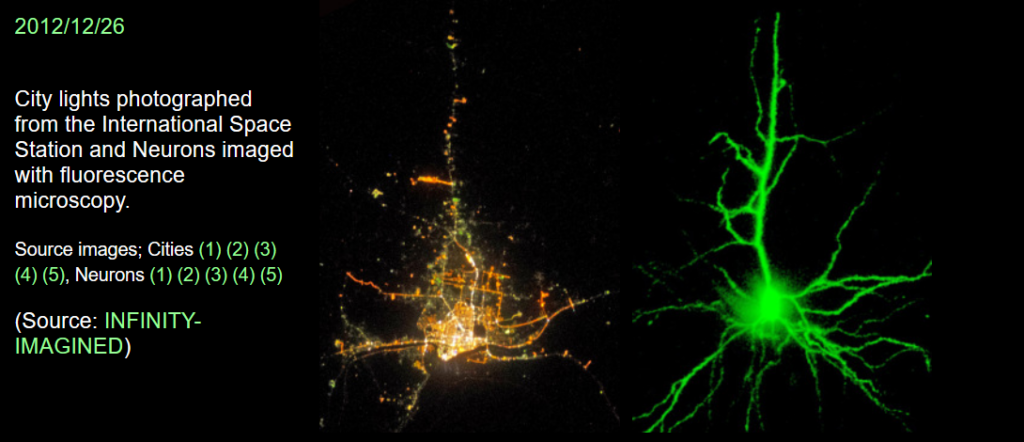Cities and cells - form and function

Image source. Click for more images!
Spatial form
The images above, of nerve cells and the nighttime lights of cities, give us an opportunity to pause and wonder the similarities of spatial form in two completely distinct things. One image, from a camera onboard the international space station, spatially characterizes aspects of a human settlement. It captures the spatial form of the city, roads and the road networks. This camera photo measures man-made light and shows one kind of evidence of the human activity on the planet's surface.
The other image was taken by neuro-scientists interested to understand how nerve cells work together to form brains. Brain provides the potential for thoughts in some animals and provide an infrastructure to communicate signals within the body.
The most basic question one might ask after looking at the images, why? Why would the cells and the city be so similar in their basic spatial pattern?
Are there other similarities?
Scale: Size
Their sizes differ by approximately of 11 orders of magnitude (For more information: LINK: order of magnitude: https://simple.wikipedia.org/wiki/Order_of_magnitude). In other words, the size of the larger (city) is about 100 000 000 000 times greater than the size of the smaller (nerve cell). Even with this size difference we easily see that both have a central mass and both have thin structures radiating from the central mass. So we can describe masses and thin structures that are similar to both.
In the cell, the radiating structures are called axons and they usually connect end-on-end forming networks. In the city, streets and highways form the thin structures leaving the central masses of cities. The cell body (soma) is the central mass for a cell and the city components (buildings, parks, roads, stores and factories) make up the city mass.
Scale: Time
The time scale of cities and nerve cells are not very similar. A city might be in existence for hundreds or thousands of years but a nerve cell is part of a living organism and they are not so long-lived. Organisms on this planet are usually living for less than 100 years. This depends on the species, as the lifetimes can differ a lot. As a rough rule-of-thumb: as size goes up, so does the average lifespan of the animal. A bacterium may last only for a day and a whale may live many, many decades.
Composition
The cities and the cells are made from different materials. Cities have buildings, ecosystems, communication systems, concrete, bricks, metals, plastics, glass and composite materials as building blocks. They have social and economic systems that guide their form and processes. By comparison, cells have various types of membranes that provide much of its structure with added organelles that provide specific actions and functions within the cell. Evolutionary processes have guided their form and associated processes.
Metabolic processes
The city and the cells parts continually breakdown during their lifetimes and both require “metabolic processes” to oppose this breakdown process. A fence needs to be periodically rebuilt or a road re-surfaced just to keep their usefulness. Similarly, the cell has to maintain the membrane structures that separate the different parts of the cell. To simply keep the cell and cities in good structural and functional "health" continuously, energy and materials from outside have to be brought into them to provide building blocks and power for the rebuilding processes. These maintenance processes in the cell and city are not 100% efficient and some of the energy is wasted in both. They also both give off waste products to their environments.
The rebuilding and waste processes within a cell and a city may be called metabolic processes. In cells, this term applies exactly, in the city we use the word metabolism as an analogy. We use the idea of metabolic processes in a city as a way of thinking about the complex set of processes that take place within the city. We approximate that these processes are complex in the city just as they are in a cell.
Form and Function
Within the cells and cities, it can be seen that the form-and-function relationships are similar.
Leaving the central masses of both the cell and city, the thin structures (cell: axons, city: roads) provide a transportation and communication infrastructure. Energy is required to transport materials along these routes for both the cell and the city. In both cases the thin structures form complex networks to permit communication of information over long distances. Both cells and cities sometimes use “one way traffic” routes when they transport materials and information.
In the central parts of both (cell: cell body (soma), city: buildings, ecosystems, communication systems, concrete, bricks, metals, plastics, glass and composite materials) the functions are also similar. Metabolic processes which can also include simple growth happens in these centers of the cities and cells.
Co-development of cells and cities
After noticing the similarities above, we can perhaps guess that man and evolution were somehow thinking alike when they produced cells and cities. But how can this be, the oldest cities are estimated to have developed over 7000 years before the first microscope?